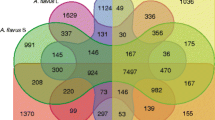Abstract
The genus Aspergillus is among the economically most important fungal genera, which contains about 350 species. They occur worldwide, and have both beneficial and harmful effects on humans, animals, and plants. Several molecular sequence-based approaches have been tested to identify Aspergillus isolates at the species level. In this chapter, we give an overview of the methods which proved to be most suitable in our experience.
Access this chapter
Tax calculation will be finalised at checkout
Purchases are for personal use only
Similar content being viewed by others
References
Samson RA, Houbraken J, Thrane U et al (2010) Food and indoor fungi. CBS KNAW Biodiversity Center, Utrecht
Raper KB, Fennell DI (1965) The genus Aspergillus. Williams & Wilkins, Baltimore
Samson RA, Visagie CM, Houbraken J et al (2014) Phylogeny, identification and nomenclature of the genus Aspergillus. Stud Mycol 78:141–173
Peterson SW (2008) Phylogenetic analyses of Aspergillus species using DNA sequences from four loci. Mycologia 100:205–226
Houbraken J, de Vries RP, Samson RA (2014) Modern taxonomy of biotechnologically important Aspergillus and Penicillium species. Adv Appl Microbiol 86:199–249
Norvell LL (2011) Fungal nomenclature. 1. Melbourne approves a new code. Mycotaxon 116:481–490
Schoch CL, Seifert KA, Huhndorf S, Robert V et al (2012) Nuclear ribosomal internal transcribed spacer (ITS) region as a universal DNA barcode marker for Fungi. Proc Natl Acad Sci U S A 109:6241–6246
Balajee SA, Houbraken J, Verweij PE et al (2007) Aspergillus species identification in the clinical setting. Stud Mycol 59:39–46
Hubka V, Kolarik M (2012) β-tubulin paralogue tubC is frequently misidentified as the benA gene in Aspergillus section Nigri taxonomy: primer specificity testing and taxonomic consequences. Persoonia 29:1–10
Hubka V, Kolarik M, Kubatova A, Peterson SW (2013) Taxonomic revision of Eurotium and transfer of species to Aspergillus. Mycologia 105:912–937
Samson RA, Hong S, Peterson SW et al (2007) Polyphasic taxonomy of Aspergillus section Fumigati and its teleomorph Neosartorya. Stud Mycol 59:147–203
Varga J, Due M, Frisvad JC, Samson RA (2007) Taxonomic revision of Aspergillus section Clavati based on molecular, morphological and physiological data. Stud Mycol 59:89–106
Visagie CM, Varga J, Houbraken J et al (2014) Ochratoxin production and taxonomy of the yellow aspergilli (Aspergillus section Circumdati). Stud Mycol 78:1–61
Varga J, Frisvad JC, Kocsubé S et al (2011) New and revisited species in Aspergillus section Nigri. Stud Mycol 69:1–17
Jurjević Z, Peterson SW, Stea G et al (2012) Two novel species of Aspergillus section Nigri from indoor air. IMA Fungus 3:159–173
Varga J, Frisvad JC, Samson RA (2011) Two new aflatoxin producing species, and an overview of Aspergillus section Flavi. Stud Mycol 69:57–80
Samson RA, Peterson SW, Frisvad JC, Varga J (2011) New species in Aspergillus section Terrei. Stud Mycol 69:39–55
Balajee SA, Baddley JW, Peterson SW et al (2009) Aspergillus alabamensis, a new clinically relevant species in the section Terrei. Eukaryot Cell 58:713–722
Hubka V, Novakova A, Kolarík A et al (2014) Revision of Aspergillus section Flavipedes: seven new species and proposal of section Jani sect. nov. Mycologia 107:169–208
Varga J, Frisvad JC, Samson RA (2007) Polyphasic taxonomy of Aspergillus section Candidi based on molecular, morphological and physiological data. Stud Mycol 59:75–88
Jurjevic Z, Peterson SW, Horn BW (2012) Aspergillus section Versicolores: nine new species and multilocus DNA sequence based phylogeny. IMA Fungus 3:59–79
Varga J, Frisvad JC, Samson RA (2010) Aspergillus sect. Aeni sect. nov., a new section of the genus for A.karnatakaensis sp. nov. and some allied fungi. IMA Fungus 1:197–205
Samson RA, Varga J, Meijer M, Frisvad JC (2011) New taxa in Aspergillus section Usti. Stud Mycol 69:81–97
Varga J, Frisvad JC, Samson RA (2010) Polyphasic taxonomy of Aspergillus section Sparsi. IMA Fungus 1:187–195
Peterson SW, Varga J, Frisvad JC et al (2008) Phylogeny and subgeneric taxonomy of Aspergillus. In: Varga J, Samson RA (eds) Aspergillus in the genomic era. Wageningen Academic Publishers, Wageningen, pp 33–56
Houbraken J, Samson RA (2011) Phylogeny of Penicillium and the segregation of Trichocomaceae into three families. Stud Mycol 70:1–51
White TJ, Bruns T, Lee S, Taylor J (1990) Amplification and direct sequencing of fungal ribosomal RNA genes for phylogenetics. In: Innis MA, Gelfand DH, Shinsky TJ, White TJ (eds) PCR Protocols: a guide to methods and applications. Academic Press Inc, New York, pp 315–322
Glass NL, Donaldson GC (1995) Development of premier sets designed for use with the PCR to amplify conserved genes from filamentous Ascomycetes. Appl Environ Microbiol 61:1323–1330
Hong SB, Go SJ, Shin HD, Frisvad JC, Samson RA (2005) Polyphasic taxonomy of Aspergillus fumigatus and related species. Mycologia 97:1316–1329
Yokoyama K, Wang L, Miyaji M, Nishimura K (2001) Identification, classification and phylogeny of the Aspergillus section Nigri inferred from mitochondrial cytochrome b gene. FEMS Microbiol Lett 200:241–246
Wang L, Yokoyama K, Takahasi H et al (2001) Identification of species in Aspergillus section Flavi based on sequencing of the mitochondrial cytochrome b gene. Int J Food Microbiol 71:75–86
Selma MV, Martínez-Culebras PV, Aznar R (2008) Real-time PCR based procedures for detection and quantification of Aspergillus carbonarius in wine grapes. Int J Food Microbiol 122:126–134
McDevitt JJ, Lees PSJ, Merz WG, Schwab KJ (2007) Inhibition of quantitative PCR analysis of fungal conidia associated with indoor air particulate matter. Aerobiologia 23:25–45
Acknowledgments
Part of the work was supported by OTKA grant No. 84077.
Author information
Authors and Affiliations
Corresponding author
Editor information
Editors and Affiliations
Rights and permissions
Copyright information
© 2017 Springer Science+Business Media LLC
About this protocol
Cite this protocol
Kocsubé, S., Varga, J. (2017). Targeting Conserved Genes in Aspergillus Species. In: Moretti, A., Susca, A. (eds) Mycotoxigenic Fungi. Methods in Molecular Biology, vol 1542. Humana Press, New York, NY. https://doi.org/10.1007/978-1-4939-6707-0_7
Download citation
DOI: https://doi.org/10.1007/978-1-4939-6707-0_7
Published:
Publisher Name: Humana Press, New York, NY
Print ISBN: 978-1-4939-6705-6
Online ISBN: 978-1-4939-6707-0
eBook Packages: Springer Protocols




